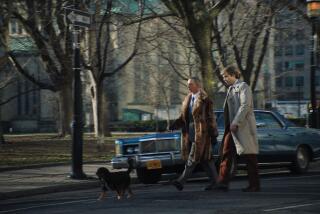Kitty Green constructs a woman-centric story of office harassment in âThe Assistantâ
In âThe Assistant,â the villain of the story â about a young woman who works in a toxic work environment ruled by a predatory movie executive â isnât given any screen time, save for a shadowy entrance early on where we donât see his face.
For Kitty Green, the filmâs writer-director, white misogynist bullies of a certain age were getting enough attention in the media when she was conceiving her story and the Harvey Weinstein scandal was dominating news coverage.
âThe Weinstein story was everywhere, and the Matt Lauer stuff,â Green recalls. âThere was so much in the press that we didnât need to explain or show. We all know whatâs going on. I wanted something woman-centric. It was more about what is preventing this woman from getting a position of power. What stops us? What gets in our way?â
Green doesnât believe in talking down to her audience. Much of her film is told through the power of suggestion â a series of micro-aggressions and slights that underscore the banality of evil. âI was trying to look at how everyday and mundane it is,â says Green. âWe werenât going to slap a soundtrack all over it and turn it into a genre piece. It was going to be quiet and minimal.â
In âThe Assistant,â Julia Garner stars as a junior aide to a Harvey Weinstein-type executive, and faces indignity and abuse in the business world.
In the film, the atmosphere of oppression is palpable, but the causes are only hinted at. We hear muffled conversations, and what sounds like the occasional outburst, behind the office door that separates the title character Jane, played by Julia Garner, from her boss. When he gets her on the phone, his voice is menacing, but we can scarcely make out what heâs saying. And Jane â relegated to the dirty work that her male assistant colleagues consider themselves above â is forced to play interference when the bossâ beleaguered wife calls demanding to know where he is and whom heâs with.
âItâs unconscious bias, this gender division of labor,â notes Green, who hails from Melbourne, Australia. âAs long as I could demonstrate that this toxic, corrosive power existed, and thatâs what ruled this work environment, then I didnât really need to dive into it any further.â
Garner, best known for her Emmy-winning work on the Netflix series âOzark,â says that when she first read Greenâs spare, 70-something-page script, she âknew that it was almost going to be a silent film.â She adds that Green âwanted this film to feel quiet because the subject [of sexual harassment and gender inequality]is so loud. And I loved that, because I feel any great art has contradictions in a way.â
Itâs an oblique approach thatâs not uncommon in Greenâs work, which was defined by such documentaries as âUkraine Is Not a Brothelâ (2013) and âCasting JonBenĂŠtâ (2017). The latter film, instead of being an exposĂŠ that attempts to solve the mystery behind JonBenĂŠt Ramseyâs murder, documents the suppositions and conspiracy theories revealed by would-be actors auditioning to play roles in a reenactment of the case, all from the Ramseysâ surrounding Boulder, Colo., community. Itâs more about media obsession and how art imitates life in sometimes creepy ways.
It was while Green was promoting âCasting JonBenĂŠtâ on the festival circuit that the seeds for âThe Assistant,â her first narrative feature, were planted. At Sundance, a festival programmer assumed she got her ideas from one of her fellow producers, James Schamus and Scott Macaulay. And this was just the beginning.
âA lot of press would come in,â says Green, who is 36 but looks at least a decade younger. âThey had a 20-minute window to see me. And theyâd take a look at me and turn to the publicist and say, âWell, Iâll only need 10.ââ
It was such a demoralizing experience that Greenâs self-confidence was shattered, and she questioned whether she even wanted to continue making films. But ultimately it inspired her to explore the underlying sexism she was exposed to, a subject that initially took the form of sexual misconduct on college campuses but pivoted when the Weinstein story broke. Like a seasoned journalist, she interviewed scores of women who worked for predatory bosses, in entertainment and beyond.
So much of âThe Assistantâ consists of routine: Jane making coffee, photocopying scripts, arranging travel itineraries, cleaning an indeterminate stain on her bossâ couch, disposing of syringes from his office into a biohazard bag.
âJuliaâs character doesnât have enough information,â Green says. âSheâs got the dots but canât connect them. Sheâs getting crude hints and evidence but not enough to prove whatâs happening. She doesnât know what sheâs cleaning off the couch. It could be yogurt, it could be semen. In that sense, weâre going on that journey with her.â
In Greenâs mind, the part required an actress with âa striking appearance, because everything sheâs doing is kind of perfunctory. Itâs quite a subtle performance in that sense, because youâre watching her being worn down and broken by the system.â
In the film, Jane â whose grinding work schedule has cut her off from loved ones â is barely acknowledged unless sheâs violating an unwritten rule. When she shares an elevator with a famous actor (an unbilled Patrick Wilson) or a group of Japanese investors, itâs as if sheâs invisible.
âI wanted the audience to experience my feelings,â Garner says, âkind of like my subconscious in a way, so you [sense] a huge isolation from the rest of the people. And thereâs nothing more lonely than being around people and still feeling alone. In a way, itâs actually worse than being by yourself.â
More to Read
From the Oscars to the Emmys.
Get the Envelope newsletter for exclusive awards season coverage, behind-the-scenes stories from the Envelope podcast and columnist Glenn Whippâs must-read analysis.
You may occasionally receive promotional content from the Los Angeles Times.










